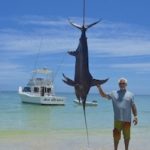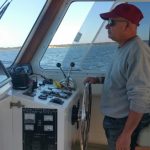Cummins Marine Diesel Repower Specialists › Forums › Cummins Marine Engines › Aftercooler core damage
- This topic has 9 replies, 6 voices, and was last updated 5 years ago by
 Jen Wren.
Jen Wren.
-
CreatorTopic
-
November 21, 2018 at 4:13 pm #43017

Jen WrenParticipantVessel Name: Vaquera
Engines: QSB 540's
Location: Baja California Sur
Country: Mexico
The photo of this core is from a 5.9 QSB 380hp with 12,000hrs. I’m glad I service the coolers every year per Tony’s instructions because this one was just starting to leak sea water. I was surprised to find a damaged surface and am hoping to get some advise on how to repair it. The housing and end caps look good and don’t appear to have any damage.
-
CreatorTopic
-
AuthorReplies
-
November 27, 2018 at 8:56 am #43616

Jen WrenParticipantVessel Name: Vaquera
Engines: QSB 540's
Location: Baja California Sur
Country: Mexico
Thanks
November 23, 2018 at 3:02 pm #43213
Rob SchepisForum ModeratorVessel Name: Tenacious
Engines: 6BTA 5.9 330's - "Seaboard Style"
Location: Long Island, NY
Country: USA
My “termite damage” was not to the extent as depicted in the images you posted. I don’t have any pictures of Tony’s solder repair but here’s the leak and the the prep for soldering.
November 22, 2018 at 7:57 pm #43128
Jen WrenParticipantVessel Name: Vaquera
Engines: QSB 540's
Location: Baja California Sur
Country: Mexico
No band-aids
Tony, Not what I wanted to hear but thanks for telling me what I needed to know. My motors take care of me and work too hard for band-aids. As much as it hurts I’ll junk the core and install a new one. Like my father always told me “they don’t make them like they used to”.
November 22, 2018 at 5:45 pm #43123
Tony AthensModeratorVessel Name: Local Banks
Engines: QSB 6.7 550 HP
Location: Oxnard, CA
Country: USA
Brass Termites
Here is what you are really dealing with…………….A good alloy of copper, tin, zinc & some misc that never used to do that, but has now gone down hill over the last 10 + yrs or so…………….No real solution at this time other than to be sure your zincs & proper service intervals per our protocols are followed and maybe do fresh water flushing.. Up to about 10 yrs ago, I never knew there were “brass termites”..The “new aftercooler” construction showed me different..
If I was trying to do a “band-aid” approach, I’d use 95-5 or a new a new silver based “SOFT solder” to repair ( like they use on copper pipes in Calif) .. Works good———————–Ask Rob S..I did his about 2 yrs ago?
Tony
November 22, 2018 at 4:23 pm #43119
Fireisland1ParticipantVessel Name: Riverwind
Engines: cummins QSB 380
Location: long island n.y.
Country: usa
Brazing with a tig welder would keep the heat isolated. If you add any type of epoxy filler and it doesn’t hold will make it very difficult or impossible to braze later. Silicone bronze would be my choice if the melting points match
November 22, 2018 at 10:29 am #43093
Jen WrenParticipantVessel Name: Vaquera
Engines: QSB 540's
Location: Baja California Sur
Country: Mexico
Thanks for the suggestions. The pitting is not very deep but if I machine the end down not only do I need to find the right 0-ring, next year I have to remember which end of which core was machined. Seems too easy to mess up and would rather keep it standard.
The Weilcon steel that Andre suggested seems to be a european product and hard to locate in the US. I was thinking about JB Weld but am hoping someone can offer a 100% fix. Can’t see inside while under operation and it could get expensive if not repaired correctly.
Another thought is taking it to a radiator shop and having it brazed. I’m just afraid if it is over heated it could effect the integrity of the whole core.
November 22, 2018 at 9:34 am #43084Jen. I have the same cores. One option depending on how deep the pitting is , is to have the ends machined down. If yo go this route you will need smaller o rings with greater thickness. Pressure test as always. I have seen this done here in San Diego. I know you in BAJA so may not be an option. If you need help state side let me know.
Mike
November 22, 2018 at 7:11 am #43075
Andre HuizingParticipantVessel Name: Mr.Bean2
Engines: QSC8.3 490hp
Location: Lemmer
Country: Netherlands
Hi Jen,
I guess this is the place where the core is supported by an O-ring and in seawater. Not sure about the theory behind this but metals always seem to develop pit-corrosion where it touches seals in salt water. E.g. the SS shafts of my stabilizers always corrode on the seals…making them leak.
I have had very good results with Weicon steel epoxy. It’s heavily used in the off shore industry. It comes also in a high temp resistant form. It’s not cheap and maybe there are other brands with same stuff. I have used it f.e. to repair a badly frozen and cracked V8 cast iron exhaust of a classic chris craft engine. It’s been sitting there now for >5 years without any problem.
When the stuff is hardened you can do anything with it that you can with steel (sanding, grinding etc.). Additional perk: it’s not metal so no more pit corrosion in that spot.
Hope this helps. Cheers, AndréNovember 21, 2018 at 4:21 pm #43019
Jen WrenParticipantVessel Name: Vaquera
Engines: QSB 540's
Location: Baja California Sur
Country: Mexico
Oops here is the photo
Having a little trouble posting the photo. Hope this works
-
AuthorReplies
You must be logged in to reply to this topic.
